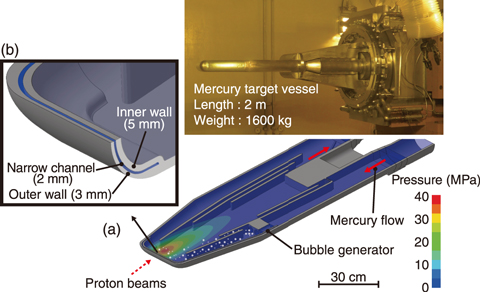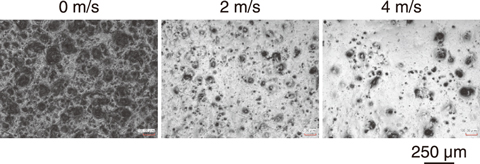
Fig.5-6 Photograph and cross sectional-image of the double-walled mercury target vessel

Fig.5-7 Macroscopic images of the damaged surface for the gap width of 2 mm in various mercury flow velocities obtained by a laser scanning microscope

Fig.5-8 Erosion damage formed on the inner wall of the mercury target vessel
At J-PARC, neutrons are produced for materials and life science research by injecting high-intensity proton beams into mercury. More high-power proton beam injection is required to increase the resolution of the neutron measurement. When the high-intensity proton beam hits the mercury in the stainless steel vessel (i.e. the target vessel), half of the proton beam energy is used for neutron production, whereas half is lost as waste heat. For a 1-MW proton beam injection (representing the goal at J-PARC), the local mercury pressure increases by approximately 40 MPa due to the instantaneous thermal expansion. The mercury pressure thus drops below the saturated vapor pressure during the propagation of the pressure wave, causing cavitation (depressurized boiling) (Fig.5-6(a)). The cavitation bubble collapses when the pressure recovers above the saturated vapor pressure, thus causing damage to the vessel wall. Since the resulting damage to the vessel wall increases with operating time and proton beam power and degrades the structural integrity of the target vessel, mitigating this damage to the vessel wall is necessary to achieve long-term high-power operation of the high-intensity proton beam.
In this work, gas microbubbles were injected into the mercury to absorb the thermal expansion of the mercury and thus mitigate the pressure waves that produce cavitation. The results showed that the pressure of the mercury was reduced by approximately one-third and the resulting damage to the vessel wall was drastically reduced. Furthermore, to achieve a high-power stable operation, an inner wall with a narrow mercury channel was adopted to contribute to the outer wall protection. In this adopted double-walled structure, shown in Fig.5-6(b). Based on the results of cavitation damage experiment, a gap width of the narrow channel of the mercury target vessel of 2 mm was selected, with a mercury flow velocity of approximately 4 m/s (Fig.5-7).
Photographs and detailed analyses of the resulting damage of the outer and inner walls of the mercury target vessel operated for 4200 hours at an average proton beam power of 430 kW are shown in Fig.5-8. The damage on the surface of the outer wall that faced the narrow channel was less than 20 μm in depth, whereas a maximum cavitation damage of approximately 260 μm in depth was formed on the inner wall. These results thus demonstrated that adopting the designed double-walled structure can drastically reduce the cavitation damage.
Future efforts to continue working toward stable operation at the world’s highest pulsed-neutron facility will include quantitative assessment of the damage caused by cavitation to the double-walled mercury target vessel while increasing the proton beam power.
(Takashi Naoe)